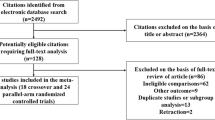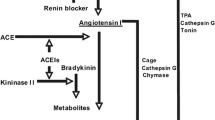Abstract
Blockade of the renin-angiotensin-aldosterone system (RAAS) prevents the development and progression of diabetic kidney disease (DKD). It is controversial whether the simultaneous use of two RAAS inhibitors (ie, dual RAAS blockade) further improves renal outcomes. This review examines the scientific rationale and current clinical evidence addressing the use of dual RAAS blockade to prevent and treat DKD. It is concluded that dual RAAS blockade should not be routinely applied to patients with low or moderate risk of progressive kidney disease (normoalbuminuria or microalbuminuria with preserved glomerular filtration rate). For patients with high risk of progressive kidney disease (substantial albuminuria or impaired glomerular filtration rate), clinicians should carefully weigh the potential risks and benefits of dual RAAS blockade on an individual basis until ongoing clinical trials provide further insight.

Similar content being viewed by others
Abbreviations
- ALTITUDE:
-
Aliskiren Trial in Type 2 Diabetes Using Cardio-Renal Endpoints
- AVOID:
-
Aliskiren in the Evaluation of Proteinuria in Diabetes
- COOPERATE:
-
Combination Treatment of Angiotensin Receptor Blocker and Angiotensin-Converting Enzyme Inhibitor in Nondiabetic Renal Disease
- IMPROVE:
-
Irbesartan in the Management of Proteinuric Patients at High Risk for Vascular Events
- NEPHRON-D:
-
Combination Angiotensin Receptor Blocker and Angiotensin-Converting Enzyme Inhibitor for Treatment of Diabetic Nephropathy
- ONTARGET:
-
Ongoing Telmisartan Alone and in Combination With Ramipril Global Endpoint Trial
- RALES:
-
Randomized Aldactone Evaluation Study
- RENAAL:
-
Reduction in Endpoints in Non-Insulin Dependent Diabetes Mellitus With the Angiotensin II Antagonist Losartan
- ROAD:
-
Renoprotection of Optimal Antiproteinuric Doses
References
Papers of particular interest, published recently, have been highlighted as: • Of importance •• Of major importance
Ruggenenti P, Fassi A, Ilieva AP, et al.: Preventing microalbuminuria in type 2 diabetes. N Engl J Med 2004, 351:1941–1951.
Mauer M, Zinman B, Gardiner R, et al.: Renal and retinal effects of enalapril and losartan in type 1 diabetes. N Engl J Med 2009, 361:40–51.
Parving HH, Lehnert H, Brochner-Mortensen J, et al.: The effect of irbesartan on the development of diabetic nephropathy in patients with type 2 diabetes. N Engl J Med 2001, 345:870–878.
Makino H, Haneda M, Babazono T, et al.: Prevention of transition from incipient to overt nephropathy with telmisartan in patients with type 2 diabetes. Diabetes Care 2007, 30:1577–1578.
Lewis EJ, Hunsicker LG, Bain RP, Rohde RD: The effect of angiotensin-converting-enzyme inhibition on diabetic nephropathy. The Collaborative Study Group. N Engl J Med 1993, 329:1456–1462.
Lewis EJ, Hunsicker LG, Clarke WR, et al.: Renoprotective effect of the angiotensin-receptor antagonist irbesartan in patients with nephropathy due to type 2 diabetes. N Engl J Med 2001, 345:851–860.
Brenner BM, Cooper ME, de Zeeuw D, et al.: Effects of losartan on renal and cardiovascular outcomes in patients with type 2 diabetes and nephropathy. N Engl J Med 2001, 345:861–869.
de Zeeuw D, Remuzzi G, Parving HH, et al.: Proteinuria, a target for renoprotection in patients with type 2 diabetic nephropathy: lessons from RENAAL. Kidney Int 2004, 65:2309–2320.
• Bomback AS, Klemmer PJ: The incidence and implications of aldosterone breakthrough. Nat Clin Pract Nephrol 2007, 3:486–492. This review details the phenomenon of aldosterone escape.
Rump LC: Secondary rise of albuminuria under AT1-receptor blockade—what is the potential role of aldosterone escape? Nephrol Dial Transplant 2007, 22:5–8.
Borch-Johnsen K, Kreiner S: Proteinuria: value as predictor of cardiovascular mortality in insulin dependent diabetes mellitus. Br Med J (Clin Res Ed) 1987, 294:1651–1654.
Gerstein HC, Mann JF, Yi Q, et al.: Albuminuria and risk of cardiovascular events, death, and heart failure in diabetic and nondiabetic individuals. JAMA 2001, 286:421–426.
Adler AI, Stevens RJ, Manley SE, et al.: Development and progression of nephropathy in type 2 diabetes: the United Kingdom Prospective Diabetes Study (UKPDS 64). Kidney Int 2003, 63:225–232.
de Boer IH, Katz R, Cao JJ, et al.: Cystatin C, albuminuria, and mortality among older adults with diabetes. Diabetes Care 2009, 32:1833–1838.
Wenzel RR, Littke T, Kuranoff S, et al.: Avosentan reduces albumin excretion in diabetics with macroalbuminuria. J Am Soc Nephrol 2009, 20:655–664.
• Mann JF, Green D, Jamerson K, et al.: Avosentan for overt diabetic nephropathy. J Am Soc Nephrol 2010, 21:527–535. This randomized clinical trial demonstrates diverging effects of the endothelin antagonist avosentan on albuminuria and clinical outcomes.
Levey AS, Cattran D, Friedman A, et al.: Proteinuria as a surrogate outcome in CKD: report of a scientific workshop sponsored by the National Kidney Foundation and the US Food and Drug Administration. Am J Kidney Dis 2009, 54:205–226.
•• Hou FF, Xie D, Zhang X, et al.: Renoprotection of Optimal Antiproteinuric Doses (ROAD) Study: a randomized controlled study of benazepril and losartan in chronic renal insufficiency. J Am Soc Nephrol 2007, 18:1889–1898. This study demonstrates that titrating dose of ACE inhibitor or ARB, guided by residual albuminuria, improves clinical renal outcomes in proteinuric, non-DKD.
• Kunz R, Friedrich C, Wolbers M, Mann JF: Meta-analysis: effect of monotherapy and combination therapy with inhibitors of the renin angiotensin system on proteinuria in renal disease. Ann Intern Med 2008, 148:30–48. This meta-analysis summarizes results of randomized clinical trials of ACE inhibitors and ARBs, alone and in combination, on albuminuria.
Schmieder RE, Klingbeil AU, Fleischmann EH, et al.: Additional antiproteinuric effect of ultrahigh dose candesartan: a double-blind, randomized, prospective study. J Am Soc Nephrol 2005, 16:3038–3045.
Hollenberg NK, Parving HH, Viberti G, et al.: Albuminuria response to very high-dose valsartan in type 2 diabetes mellitus. J Hypertens 2007, 25:1921–1926.
Burgess E, Muirhead N, Rene de Cotret P, et al.: Supramaximal dose of candesartan in proteinuric renal disease. J Am Soc Nephrol 2009, 20:893–900.
• Bomback AS, Kshirsagar AV, Amamoo MA, Klemmer PJ: Change in proteinuria after adding aldosterone blockers to ACE inhibitors or angiotensin receptor blockers in CKD: a systematic review. Am J Kidney Dis 2008, 51:199–211. This systematic review describes effects of spironolactone on albuminuria when added to an ACE inhibitor and/or ARB.
• Mehdi UF, Adams-Huet B, Raskin P, et al.: Addition of angiotensin receptor blockade or mineralocorticoid antagonism to maximal angiotensin-converting enzyme inhibition in diabetic nephropathy. J Am Soc Nephrol 2009, 20:2641–2650. This randomized clinical trial tests effects of spironolactone and losartan (in parallel) on albuminuria, when added to high-dose lisinopril among persons with diabetes and albuminuria.
• Parving HH, Persson F, Lewis JB, et al.: Aliskiren combined with losartan in type 2 diabetes and nephropathy. N Engl J Med 2008, 358:2433–2446. This randomized clinical trial demonstrates that the direct renin inhibitor aliskiren reduces albuminuria when combined with losartan in the setting of DKD.
Nguyen G: The (pro)renin receptor in health and disease. Ann Med 2010, 42:13–18.
Wilson DM, Luetscher JA: Plasma prorenin activity and complications in children with insulin-dependent diabetes mellitus. N Engl J Med 1990, 323:1101–1106.
Daneman D, Crompton CH, Balfe JW, et al.: Plasma prorenin as an early marker of nephropathy in diabetic (IDDM) adolescents. Kidney Int 1994, 46:1154–1159.
Huang Y, Wongamorntham S, Kasting J, et al.: Renin increases mesangial cell transforming growth factor-beta1 and matrix proteins through receptor-mediated, angiotensin II-independent mechanisms. Kidney Int 2006, 69:105–113.
Ichihara A, Suzuki F, Nakagawa T, et al.: Prorenin receptor blockade inhibits development of glomerulosclerosis in diabetic angiotensin II type 1a receptor-deficient mice. J Am Soc Nephrol 2006, 17:1950–1961.
Li YC, Kong J, Wei M, et al.: 1,25-Dihydroxyvitamin D(3) is a negative endocrine regulator of the renin-angiotensin system. J Clin Invest 2002, 110:229–238.
Zhang Z, Zhang Y, Ning G, et al.: Combination therapy with AT1 blocker and vitamin D analog markedly ameliorates diabetic nephropathy: blockade of compensatory renin increase. Proc Natl Acad Sci U S A 2008, 105:15896–15901.
de Boer IH, Ioannou GN, Kestenbaum B, et al.: 25-Hydroxyvitamin D levels and albuminuria in the Third National Health and Nutrition Examination Survey (NHANES III). Am J Kidney Dis 2007, 50:69–77.
Ravani P, Malberti F, Tripepi G, et al.: Vitamin D levels and patient outcome in chronic kidney disease. Kidney Int 2009, 75:88–95.
Melamed ML, Astor B, Michos ED, et al.: 25-hydroxyvitamin D levels, race, and the progression of kidney disease. J Am Soc Nephrol 2009, 20:2631–2639.
De Zeeuw D: Selective vitamin D receptor activator (VDRA) for albuminuria lowering (VITAL) study in type 2 diabetic nephropathy [abstract]. Presented at the American Society of Nephrology Renal Week. San Diego, CA; October 30, 2010.
Nakao N, Yoshimura A, Morita H, et al.: Combination treatment of angiotensin-II receptor blocker and angiotensin-converting-enzyme inhibitor in non-diabetic renal disease (COOPERATE): a randomised controlled trial. Lancet 2003, 361:117–124.
Kunz R, Wolbers M, Glass T, Mann JF: The COOPERATE trial: a letter of concern. Lancet 2008, 371:1575–1576.
Retraction—Combination treatment of angiotensin-II receptor blocker and angiotensin-converting-enzyme inhibitor in non-diabetic renal disease (COOPERATE): a randomised controlled trial [no authors listed]. Lancet 2009, 374:1226.
•• Yusuf S, Teo KK, Pogue J, et al.: Telmisartan, ramipril, or both in patients at high risk for vascular events. N Engl J Med 2008, 358:1547–1559. This randomized clinical trial demonstrated no benefit to dual RAAS blockade for prevention of cardiovascular events among participants with clinical cardiovascular disease or diabetes with end-organ damage.
•• Mann JF, Schmieder RE, McQueen M, et al.: Renal outcomes with telmisartan, ramipril, or both, in people at high vascular risk (the ONTARGET study): a multicentre, randomised, double-blind, controlled trial. Lancet 2008, 372:547–553. This analysis of renal outcomes in the randomized clinical trial ONTARGET demonstrated no benefit and potential harm to dual RAAS blockade for the prevention of progressive kidney disease among participants at generally low renal risk.
Foley RN, Murray AM, Li S, et al.: Chronic kidney disease and the risk for cardiovascular disease, renal replacement, and death in the United States Medicare population, 1998 to 1999. J Am Soc Nephrol 2005, 16:489–495.
Bakris GL, Ruilope L, Locatelli F, et al.: Treatment of microalbuminuria in hypertensive subjects with elevated cardiovascular risk: results of the IMPROVE trial. Kidney Int 2007, 72:879–885.
Pitt B, Zannad F, Remme WJ, et al.: The effect of spironolactone on morbidity and mortality in patients with severe heart failure. Randomized Aldactone Evaluation Study Investigators. N Engl J Med 1999, 341:709–717.
Juurlink DN, Mamdani MM, Lee DS, et al.: Rates of hyperkalemia after publication of the Randomized Aldactone Evaluation Study. N Engl J Med 2004, 351:543–551.
Fried LF, Duckworth W, Zhang JH, et al.: Design of combination angiotensin receptor blocker and angiotensin-converting enzyme inhibitor for treatment of diabetic nephropathy (VA NEPHRON-D). Clin J Am Soc Nephrol 2009, 4:361–368.
Parving HH, Brenner BM, McMurray JJ, et al.: Aliskiren Trial in Type 2 Diabetes Using Cardio-Renal Endpoints (ALTITUDE): rationale and study design. Nephrol Dial Transplant 2009, 24:1663–1671.
Disclosure
Dr. Raimund H. Pichler received honoraria for lectures for Boehringer Ingelheim and for Novartis. Dr. Ian H. de Boer receives research grant funding from Abbott Laboratories.
Author information
Authors and Affiliations
Corresponding author
Rights and permissions
About this article
Cite this article
Pichler, R.H., de Boer, I.H. Dual Renin-Angiotensin-Aldosterone System Blockade for Diabetic Kidney Disease. Curr Diab Rep 10, 297–305 (2010). https://doi.org/10.1007/s11892-010-0126-2
Published:
Issue Date:
DOI: https://doi.org/10.1007/s11892-010-0126-2




